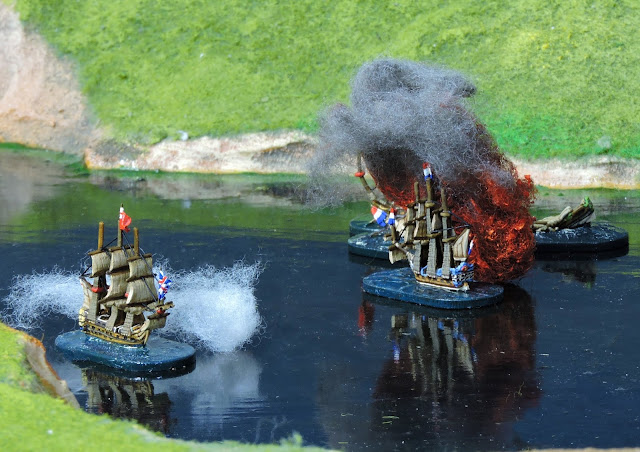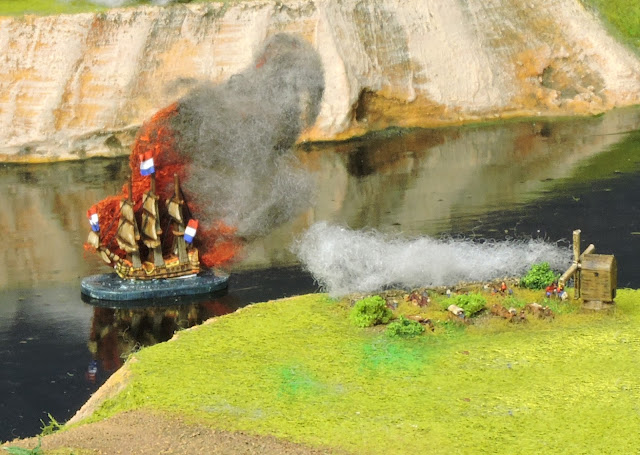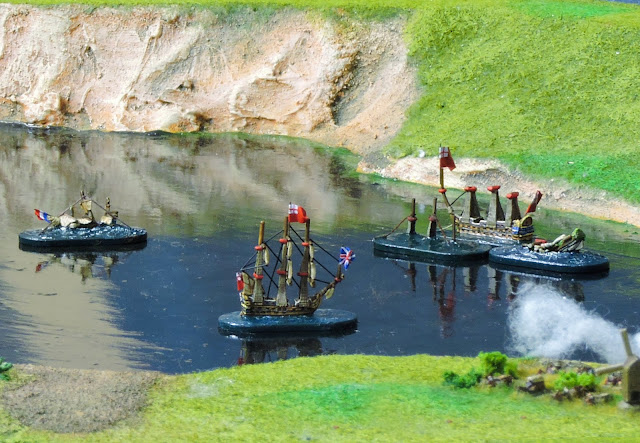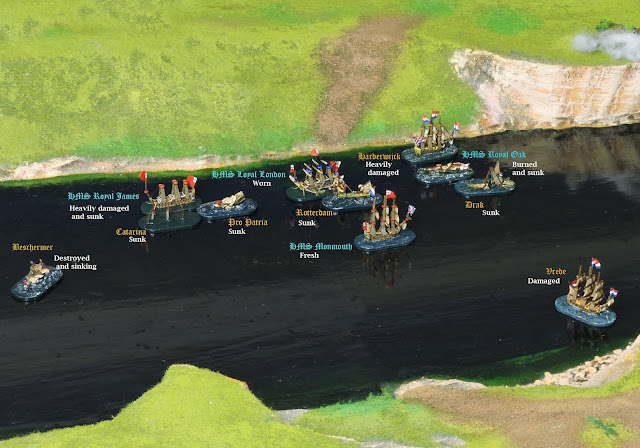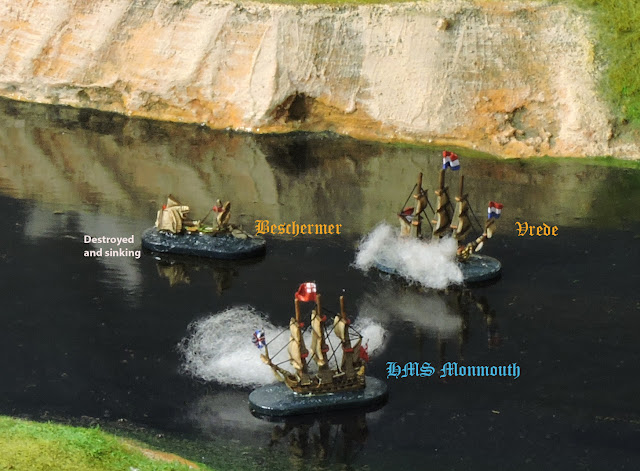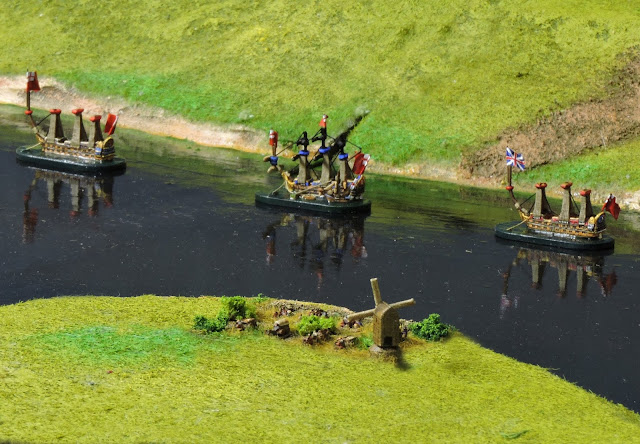 |
| The battleships lie at anchor watched over by the Eastern Shore Battery commanded by Spragge. |
Turn 1.
The Dutch sailed upriver from Upnor Reach in line ahead with the frigate Harderwijck leading the way followed by the Fireships Catarina, Pro Patria, Rotterdam and Drak in that order. Ahead lay gun batteries on both the east and west bank consisting of heavy artillery transported from Gravesend and positioned to guard the anchored warships.
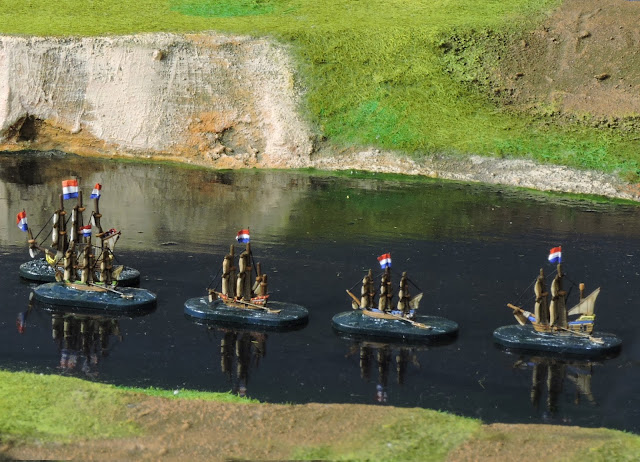 |
| Sailing in line astern in the narrow eastern channel the Fireships head upriver on their one way mission. |
Turn 2.
The leading Dutch veseels came under the muzzles of the shore batteries which opened up with a hot fire causing damage to Harderwijck and Catarina. The Dutch frigate returned fire against the nearer east shore as the squadron was sailing in an eastern channel. By the end of the turn Rotterdam and Drak had altered course and were pointing toward their respective targets HMS Loyal London and HMS Royal Oak.
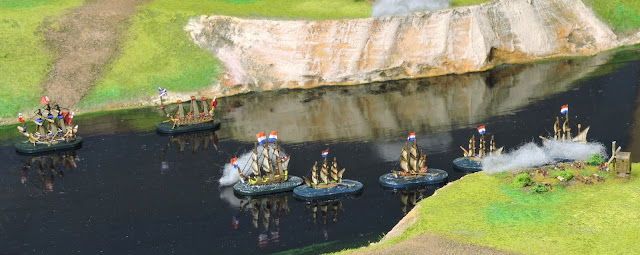 |
| Rotterdam and Drak alter course to line up their attackon the northernmost English ships. |
Turn 3.
With Harderwijck sheperding both Catarina and Pro Patria, further upriver towards HMS Royal James the shore batteries continued to blast away at the attackers. The English barrage was so intense that Drak caught fire and Catarina's captain was killed when HMS Loyal London opened up on her as she sailed past towards her target. The impact of this catastrophic damage caused the crew morale aboard the fireship to drop to DRILLED. The Dutch absorbed huge punishment during this turn but pressed home their attack with resolution.
 |
| Loyal London engages Catarina whilst the shore batteries set the combustible Drak alight. |
Turn 4.
The Dutch fired Catarina, Pro Patria and Rotterdam whose crews abandoned them. The first two hit HMS Royal James but her skelton crew were able to fend off the fireships and the flames did not spread to the battleship. Pro Patria hit HMS Loyal London but again the English crew was able to fend off the attack and the flames did not catch on the battleship. The crew onboard Drak fought furiously to put out the fire started by the shore batteries that their vessel, made safe, crashed into the side of HMS Royal Oak causing minor damage to the larger vessel and much more to the fireship. Had the crew left their vessel burning it may have proved a wiser choice.
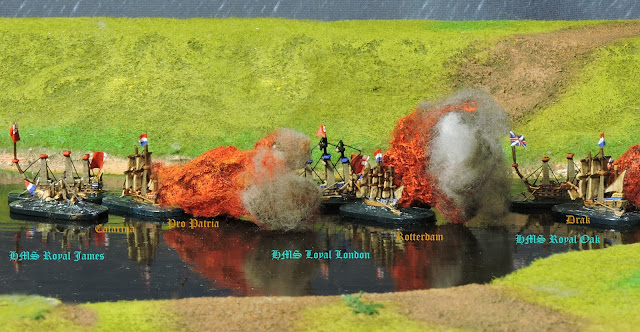 |
| Turn 5 - Catarina is already partially sunk whilst the flaming Dutch ships fail to ignite their targets. |
Turn 5.
The fireships bumped alongside the battleships burning down but relatively ineffective. The lack of men on each of the English ships prevented the enemy vessels being pushed out of harms way. Whilst this was playing out Harderwijck had sailed further up river and began to come about. Her captain soon realized that to avoid collision with the inferno around HMS Royal James he was going to have to steer his vessel down the shallow strip of water between the western shore and the battleships. This tricky manoeuvre carried a very high risk of grounding.
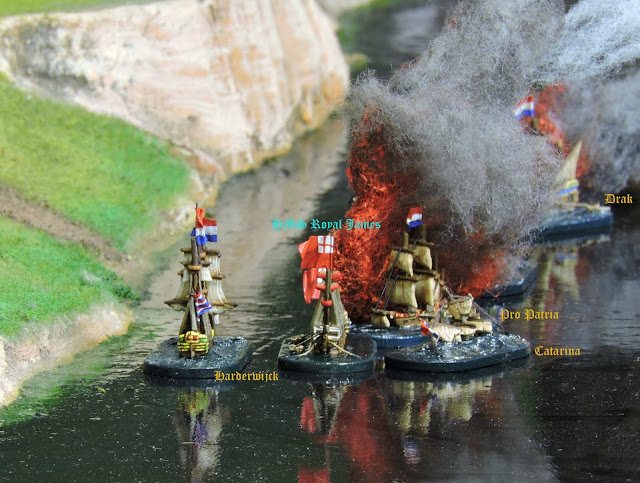 |
| T6 Harderwijck begins her precarious Run down the Shallows! |
Turn 6.
At a distance of barely twenty yards Harderwijck poured a devastating broadside into HMS Royal James holing her below the waterline multiple times and causing the English vessel to begin sinking in the shallow channel. The Dutchman tried to hold position but the current carried her past the now damaged giant. Elsewhere the efforts of the English skeleton crews to contain the fires onboard the enemy ships were successful.
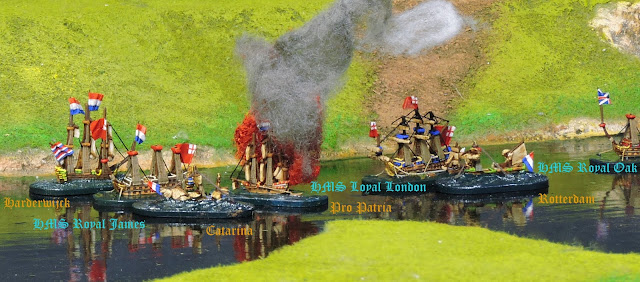 |
| Rotterdam is now also a smouldering and waterlogged hulk like Catarina - their mission is failed and over. |
Turn 7.
As Harderwijck came abreast of HMS Loyal London she bottomed and got stuck. Her fire on the enemy ship at such close range was not effectual and to make matters worse HMS Monmouth appeared south of Chatham Dockyard ready for battle. The Beschermer disengaged from Upnor Castle and prepared to run the gauntlet through the shore batteries which were now trained upstream on the smoke and mayhem around the battleships.
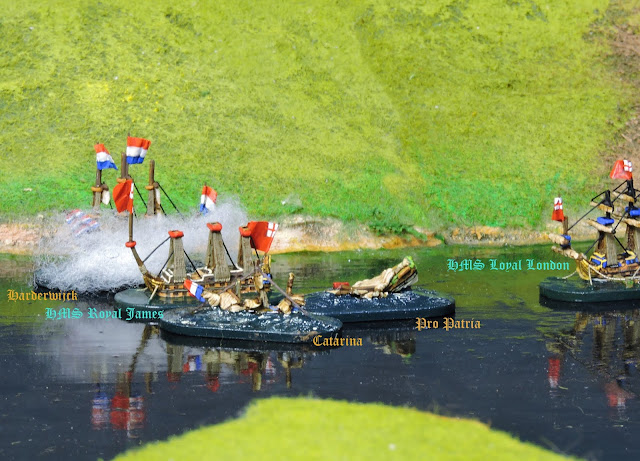 |
| Pro Patria too has sunk but Harderwijck's broadside rips the hull of Royal James which begins to sink. |
Turn 8.
With her crew trying frantically to refloat, Harderwijck took the starboard broadside of HMS Loyal London from a range of around 15 yards which ripped through her main gun deck destroying nearly every piece. The force of the blast may well have contributed to her shortly afterward easing herself off the bottom and slipping down river sorely hurt. On the northern reach Beschermer's gunnery was so accurate that it temporarily put the western shore battery out of action as she slipped through the jaws and upriver toward the fast closing HMS Monmouth. Notwithstanding their finest efforts the crew of HMS Royal Oak lost the fight against the flames which finally started to take hold through her open gun ports. By now two of the battleships were in very difficult positions. HMS Royal James had very quickly settled on the bottom but still had her upper gun ports above the water whilst HMS Royal Oak was burning with the conflagration spreading quickly below decks.
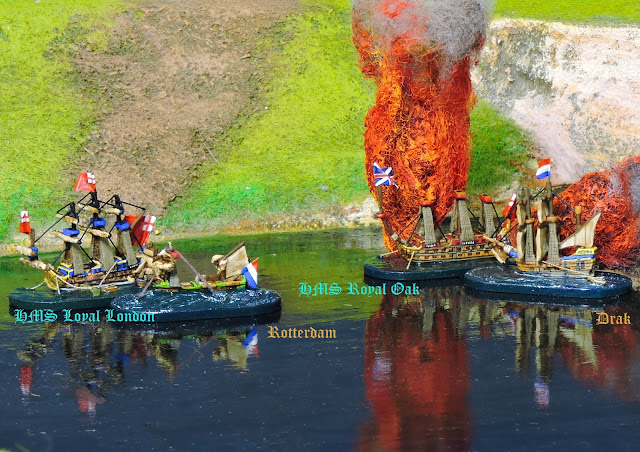 |
| Royal Oak finally burning as the wrecked Drak begins to slip under the water by her side - mission complete. |
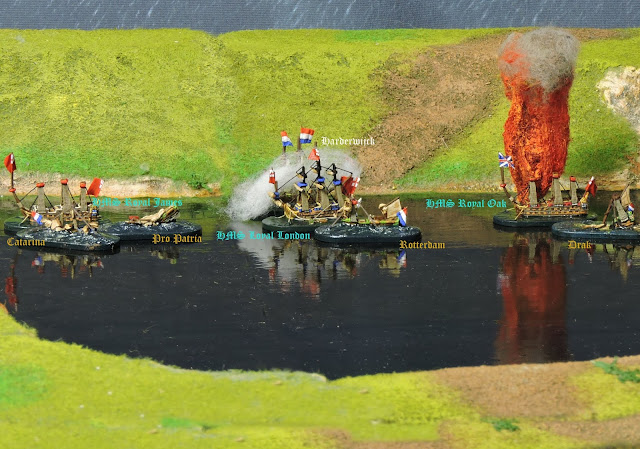 |
| T8 As Royal Oak blazes Harderwijck runs the shallows and exchanges fire with Loyal London |
Turn 9.
Although this scenario did not seem hopeful from an English perspective as it commenced, sinking three battleships takes a lot of effort. Harderwijck had steadily accrued damage during the action and on passing the still operational HMS Loyal London the frigate sustained further punishment. English hopes lay with the arrival of the modern and powerful 3rd Rate HMS Monmouth although the Vrede was also making speed from Upnor to reinforce the Dutch attack.
Turn 10.
Beschermer came abreast HMS Royal James pumping in a further broadside which saw the 1st Rate almost destroyed. HMS Monmouth redressed the balance with the most devastating fire of the battle scoring seven hits on Beschermer which rocked the ship and forced her captain to consider his escape from the battle. In the moment when the Dutch appeared able to claim their victory the newly arrived Vrede was smashed by fire from the East Shore Battery and caught fire.
Turn 11.
Vrede got the fire under control but was too late to make any real contribution to the battle.Harderwijck barely afloat and drifting more than sailing down river slipped past the exploded and now sunken HMS Royal Oak. As Beschermer awkwardly attempted to turn to head down river
HMS Monmouth poured in the coup de grace and the Dutchman, dis-masted and with her crew abandoning ship, struck her colours just below Chatham Dockyard.
Turn 12.
Vrede and Harderwijck manouevred out of the combat zone whilst HMS Monmouth hesitated from pursuing too far down river. The battle was over. All of the Dutch fireships were spent and sunk. HMS Royal James lay on the bottom and so severely damaged that she was likely to prove unsalvagable. HMS Royal Oak had capsized and sunk after exploding. HMS Loyal London remained relatively intact although she had taken some minor damage. Beschermer had been lost and her crew captured. By the terms of the scenario it was a very hard fought Dutch victory but the English had made much more of a fight that had been expected.
Postscript
I fought on to determine whether HMS Monmouth could turn the result around. By Turn 15 she had overtaken and sunk the limping Harderwijck just above Upnor Castle. Vrede made it to safety and the English ship would not have pursued for fear of suffering a similar fate from the rest of the Dutch squadron in Upnor Reach.
On Friday August 9th I started work on the real terrain board for this part of the campaign. Updates on its building soon.

